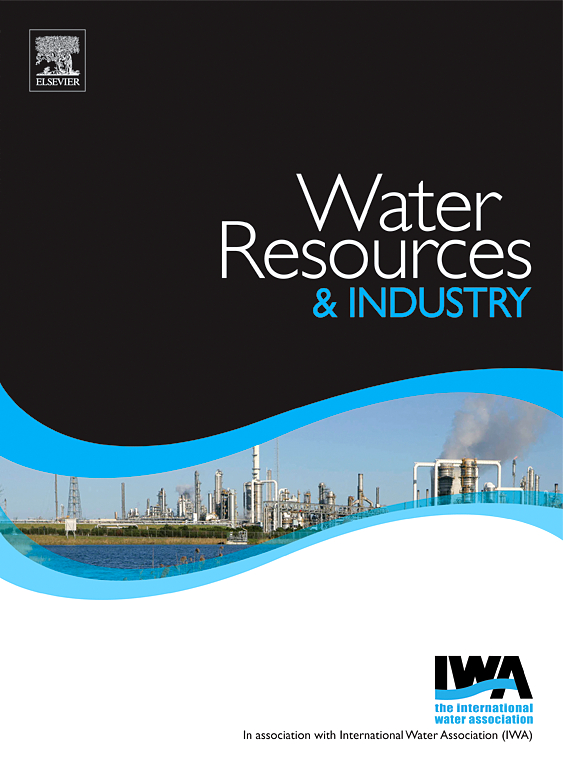响应面法在优化MOF5@Fe3O4活化过氧单硫酸盐催化剂降解活性黑5染料中的应用
IF 7.5
3区 工程技术
Q1 WATER RESOURCES
引用次数: 0
摘要
将磁性纳米颗粒(Fe3O4)负载在金属有机骨架(MOF-5)上,作为过氧单硫酸盐(PMS)分解染料活性黑5 (RB5)的活化剂。采用响应面法结合中心复合设计(RSM-CCD)对实验参数进行建模和优化。在实验室条件下,包括pH为11、催化剂用量为1 g/L、RB5浓度为10 mg/L、温度为50℃、反应时间为60 min,预测了RB5的最大去除率。较高的置信系数(R2)和f值表明,该模型可以解释大部分数据,也可用于在设计空间内预测效率。吸附量为99.2 mg/g。MOF-5@Fe3O4/PMS体系去除RB5的效率高于吸附和PMS等独立体系。稳定性测试表明,合成的催化剂可以重复使用6个连续的反应周期,染料去除率(4.3%)和总有机碳(TOC)去除率(5.50%)的下降可以忽略不计。利用乙醇和叔丁醇清除剂进行的捕集实验证实,在染料分解过程中存在硫酸盐(SO4•-)和羟基(•OH)自由基。随着催化时间的增加,对COD的去除率和BOD5/COD的去除率均有所提高,在120 min时分别达到87.93%和0.84。采用大水蚤对处理后的RB5溶液的LC50值进行了测定,结果表明处理后的RB5溶液的LC50值有所增加。本文章由计算机程序翻译,如有差异,请以英文原文为准。

Application of response surface methodology in optimizing MOF5@Fe3O4 catalyst for activating peroxymonosulfate in the degradation of reactive black 5 dye
Magnetic nanoparticles (Fe3O4) were loaded onto metal-organic framework (MOF-5) as an activator for peroxymonosulfate (PMS) in the decomposition of the dye reactive black 5 (RB5). Modeling and optimization of operational parameters were performed using response surface methodology coupled with central composite design (RSM-CCD). The maximum removal efficiency of RB5 was predicted under laboratory conditions, including pH of 11, catalyst dosage of 1 g/L, RB5 concentration of 10 mg/L, temperature of 50 °C, and reaction time of 60 min. High values of confidence coefficient (R2) and F-value indicated that the present model could explain most of the data and could also be used to predict efficiency within a design space. Also, the adsorption capacity was equal to 99.2 mg/g. The efficiency of the MOF-5@Fe3O4/PMS system in removing RB5 was higher than that of standalone systems such as adsorption and PMS. Stability tests revealed that the synthesized catalyst could be reused for six consecutive reaction cycles with a negligible decline in dye removal efficiency (<4.3 %) and total organic carbon (TOC) removal (<5.50 %). Trapping experiments using ethanol and tert-butyl alcohol scavengers confirmed the presence of sulfate (SO4•-) and hydroxyl (•OH) radicals in dye decomposition. The removal efficiency of COD and the BOD5/COD ratio improved with increasing catalytic time, reaching 87.93 % and 0.84, respectively, at 120 min. The LC50 value of untreated and treated RB5 solutions was examined using Daphnia magna, and findings showed an increase in the LC50 value of the treated solution.
求助全文
通过发布文献求助,成功后即可免费获取论文全文。
去求助
来源期刊

Water Resources and Industry
Social Sciences-Geography, Planning and Development
CiteScore
8.10
自引率
5.90%
发文量
23
审稿时长
75 days
期刊介绍:
Water Resources and Industry moves research to innovation by focusing on the role industry plays in the exploitation, management and treatment of water resources. Different industries use radically different water resources in their production processes, while they produce, treat and dispose a wide variety of wastewater qualities. Depending on the geographical location of the facilities, the impact on the local resources will vary, pre-empting the applicability of one single approach. The aims and scope of the journal include: -Industrial water footprint assessment - an evaluation of tools and methodologies -What constitutes good corporate governance and policy and how to evaluate water-related risk -What constitutes good stakeholder collaboration and engagement -New technologies enabling companies to better manage water resources -Integration of water and energy and of water treatment and production processes in industry
 求助内容:
求助内容: 应助结果提醒方式:
应助结果提醒方式:


